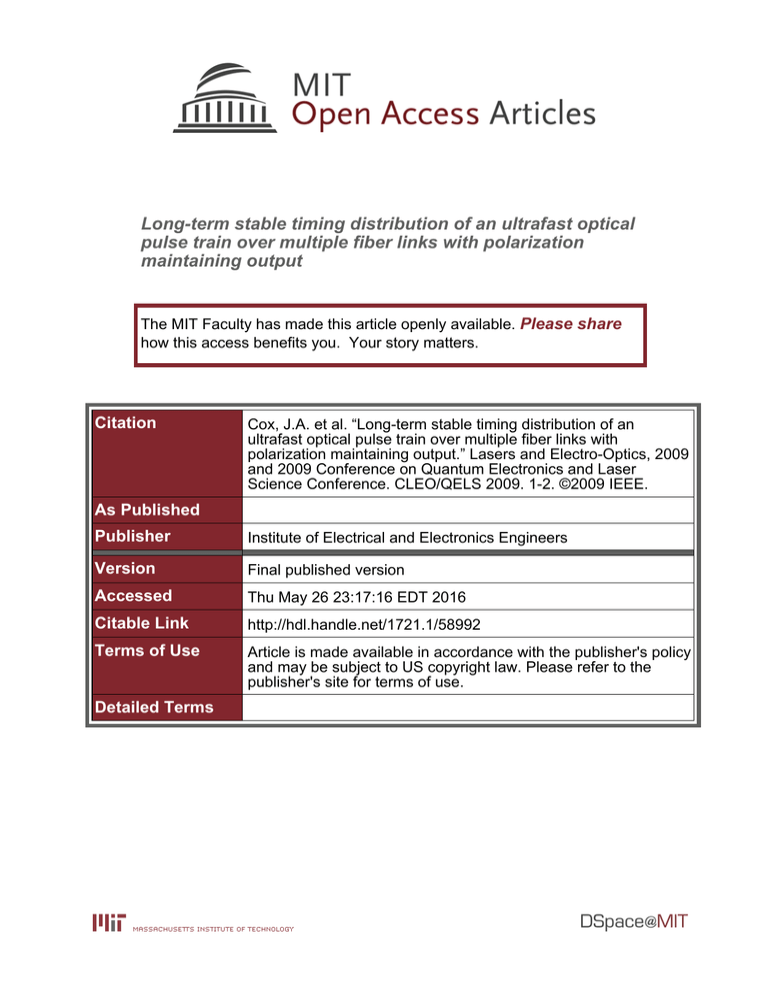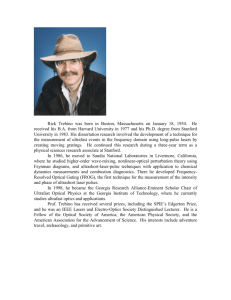Long-term stable timing distribution of an ultrafast optical
advertisement

Long-term stable timing distribution of an ultrafast optical pulse train over multiple fiber links with polarization maintaining output The MIT Faculty has made this article openly available. Please share how this access benefits you. Your story matters. Citation Cox, J.A. et al. “Long-term stable timing distribution of an ultrafast optical pulse train over multiple fiber links with polarization maintaining output.” Lasers and Electro-Optics, 2009 and 2009 Conference on Quantum Electronics and Laser Science Conference. CLEO/QELS 2009. 1-2. ©2009 IEEE. As Published Publisher Institute of Electrical and Electronics Engineers Version Final published version Accessed Thu May 26 23:17:16 EDT 2016 Citable Link http://hdl.handle.net/1721.1/58992 Terms of Use Article is made available in accordance with the publisher's policy and may be subject to US copyright law. Please refer to the publisher's site for terms of use. Detailed Terms a1449_1.pdf CTuS1.pdf CTuS1.pdf © 2009 OSA/CLEO/IQEC 2009 Long-Term Stable Timing Distribution of an Ultrafast Optical Pulse Train over Multiple Fiber Links with Polarization Maintaining Output Jonathan A. Cox, Jungwon Kim, Jian Chen and Franz X. Kärtner Department of Electrical Engineering and Computer Science, Massachusetts Institute of Technology, 77 Massachusetts Ave., Cambridge, MA 02139; joncox@mit.edu Abstract: The distribution of an ultrafast optical pulse train over multiple fiber links with longterm stable timing precision within 2 femtoseconds rms is accomplished by integrating a polarization maintaining output with 300 meter long fiber links. ©2009 Optical Society of America OCIS codes: (060.2360) Fiber optics links and subsystems; (320.7160) Ultrafast technology Ultrafast optical timing distribution over fiber optics allows for the precise synchronization of many distant points in space. Femtosecond-performance timing synchronization greatly aids the development of next-generation time and phase sensitive systems, such as X-ray free electron lasers (XFEL) [1]. In particular, ultrafast timing distribution of the pulse train from a low-noise, modelocked laser transmits the entire frequency comb, providing not only an ultrafast optical signal for laser-to-laser synchronization, but also the RF harmonics—not just a single harmonic and optical carrier [2]. These harmonics are useful for laser-to-electronics synchronization, which can be done with high precision using a balanced optical-microwave phase detector [1]. Furthermore, by using a periodically poled KTP (PPKTP) balanced cross-correlator for timing measurement, we achieve immunity to temperature-and amplitude-tophase conversion which is a limiting factor to a direct, photodiode detection scheme [3]. To provide continuous femtosecond level timing distribution, we have integrated polarization maintaining fiber outputs with an intra-link polarization control feedback system. As a result, we have demonstrated an ultrafast timing distribution system with two, 300 meter long fiber links capable of long-term stable operation with precision of 2 fs rms over 24 hours of operation. We expect that this polarization maintaining timing link is fully capable of such performance over an indefinite period of time. The system operates by stabilizing the total group delay of a dispersion compensated single mode fiber (SMF) link with a motorized free space delay and a piezoelectric fiber stretcher, as shown in Fig. 1. In this way, a ~100 fs pulse train from a 200 MHz fiber laser is delivered across 300 meters of fiber. Measurement of the optical delay is made by performing an optical cross-correlation between a new pulse entering the link from the laser and an old pulse that was reflected back from the end of the link by the 50 percent faraday rotating mirror (FRM). This cross-correlation is performed with a PPKTP balanced cross-correlator, providing a measurement of the delay between the two pulses [1]. This error signal, in turn, drives the loop filter that controls the fiber stretcher in order to remove the fast fiber length fluctuations. The closed-loop bandwidth of this system is approximately 1 kHz, which is sufficient to eliminate the vast majority of thermal and acoustic fiber fluctuations. The motor controller monitors the loop filter output and adjusts the free space delay to keep the loop filter in range. In addition, an in-loop EDFA is implemented to overcome the link losses. The output of the EDFA is fed into a polarization controlling feedback system which maintains constant polarization into the PM fiber that runs to the FRM outputs. To assess the performance of the system, we built two independent and nearly identical timing links, based on the previously reported design [4]. The output of both links was then compared with a third out-of-loop crosscorrelator to determine the relative timing drift and jitter between the two outputs. Fig. 2 shows the fiber spool temperature, motor delay and residual timing drift as measured by the out-of-loop cross-correlator. The motor delay reveals the actual fiber drift which the system corrects for, largely from slow thermal fluctuations. The residual timing drift between the two links remains within 11 fs pk-pk, or 2.2 fs rms for a 24 hour period. The polarization maintaining output allows for indefinite operation without errors caused by fiber birefringence drifts. Without a polarization maintaining output, long-term, femtosecond, laser-to-laser synchronization of remote lasers would be severely compromised since the birefringence can readily drift to an orthogonal state within a day or two. Currently, we believe that the residual, out of loop timing drift is primarily the result of polarization mode dispersion in the SMF link, as the residual drift is consistent with the PMD of the link, while other sources of timing error have been accounted for. As a result, we aim to report on the continued progress of the polarization maintaining timing link at the conference in order to achieve a greater reduction in PMD-induced drift. 978-1-55752-869-8/09/$25.00 ©2009 IEEE a1449_1.pdf CTuS1.pdf CTuS1.pdf © 2009 OSA/CLEO/IQEC 2009 Figure 1: A schematic representation of the dual timing distribution with polarization maintaining outputs used for out-of-loop drift measurements between independent links. Figure 2: The experimental results of the 300 meter, polarization maintaining timing link test are shown above for 24 hours of operation. The top plot shows the temperature of the fiber spools. The center plot shows the associated group delay drift of the fiber link which was corrected for by the motors. The residual out of loop timing drift of 2.2 fs rms or 11 fs pk-to-pk, over 24 hours, is shown in the lower plot. References [1] [2] [3] [4] J. Kim, J.A. Cox, J.J. Chen, F.X. Kärtner, "Drift-free femtosecond timing synchronization of remote optical and microwave sources with better than 10-19-level stability," Nature Photonics, Vol. 2, pp. 733-736 (2008). I. Coddington, et al., “Coherent optical link over hundreds of meters and hundreds of terahertz with subfemtosecond timing jitter,” Nature Photonics, Vol. 1, 283-287 (2007). G. Marra, S. Lea, H. Margolis and P. Gill, “Fibre Transfer of High Stability Microwave References with Optical Frequency Combs,” Proc. of CLEO 2008, San Jose, CA. J.A. Cox, J. Kim, J. Chen, F.X. Kärtner, “Sub-femtosecond Timing Distribution of an Ultrafast Optical Pulse Train over Multiple Fiber Links,” Proc. of CLEO 2008, San Jose, CA.







